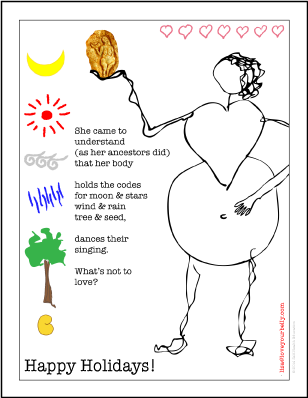Winter Solstice and Christmas stories are all about birthing: the light returns, the divine becomes human.
Embodiment.
Happy Holidays!
Before I continue about Magdalene, Mary, and birth-giving, ending with a prayer for us all, here are four versions of my season's greetings card for you (including one in French), images celebrating embodiment. Clicking on each thumbnail will take you to a larger display.
Version Birth
The stories surrounding Mary and Magdalene present different versions of birth-giving: one virginal, the other not so much.
Mary's miracle-style birth-giving is well-reported and classically virginal. Some suggest that spiritually adept women have, through time, prepared themselves to birth parthenogenetically — no male consort required — in order to bring an avatar, a world-changing holy person, into being.
Magdalene's woman-style birth-giving, Jesus having been her consort, has long been hushed, largely relegated to fiction — yet legends continue in the south of France, Margaret Starbird's The Woman with the Alabaster Jar, and Dan Brown's Da Vinci Code.
Such legends contend that Magdalene gave birth to Sarah, also known as Sara-la-Kali. The Roma (gypsies) recognize Sarah as their patron saint. Making a yearly pilgrimage to the coastal Saintes-Maries-de-la Mer (Saints Marys of the Sea), they celebrate Sarah's arrival by boat from Jerusalem.
Sarah arrived with a number of refugees, said to include Mary Magdalene, Mary Jacobe, and Mary Salome; one of the site's original names is la Ville-des-Trois-Maries (the City of the Three Marys).
Three Marys
Three Marys. I feel such a resonance with the significance of three. Do you? It's archetypal. I have the sense that something — one or two someones — is missing from the Christmas story as it's so often told.
Some suggest that the Egyptian story of Isis, Osiris, and Horus presents a parallel to the Christmas story. Briefly, in one of many versions, Isis is sister, wife, and mother to Osiris.
A vengeful rival murders Osiris, cuts his body into pieces, scatters the fragments. Isis gathers the fragments and pieces them together. Having re-membered her husband's body, she impregnates herself. Giving birth to a child, Horus, she rebirths Osiris. Horus grows up to become Osiris and the cycle continues.
Isis, presented in mythic terms, is sister-wife-mother. She is three-in-one.
Who Lost the Marys?
The conventional Christmas story gives us only one Mary, the parthenogenetic mother Mary. Where are sister Mary and wife Mary?
I suspect that at least two cultural processes have cut them from the scene. One is literalization. One woman as sister and wife and mother? Eew. We really don't want Oedipus Rex in a Santa Claus suit under the Christmas tree now, do we? We take our stories literally these days, losing the mythic meaning-by-metaphor.
The other is fragmentation and loss. We separate out aspects of the once-whole Great Goddess into distinct representations, then choose to keep some aspects and abandon others.
A Prayer
In this and every season, may we re-member our original wholeness. May we open to and embody the light that surrounds us. May we know ourselves as sacred beings.



